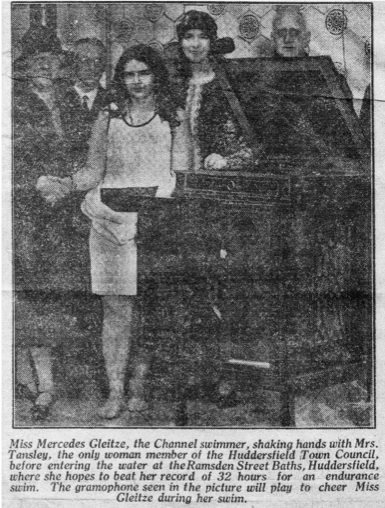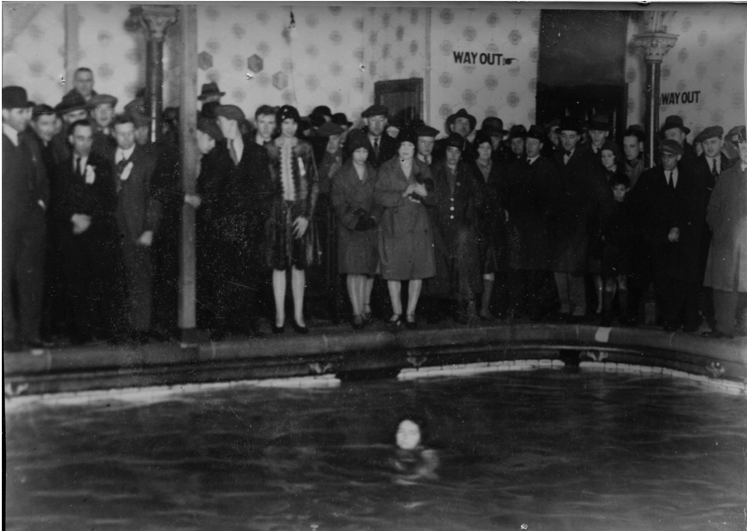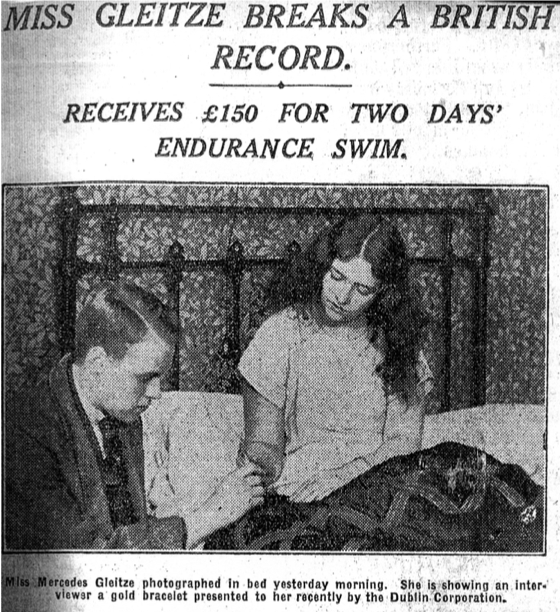Huddersfield (33 hours) – 4 to 5 April 1930
Ramsden Street Central Baths
This was the first of two endurance swims carried out in Huddersfield, the second of which took place in 1933.
Mercedes had succeeded in getting permission in February from the Huddersfield Baths Committee to carry out the swim. Whilst training for her Derby swim, she was in correspondence with Mr Arthur H. Robinson, the Superintendent of the Huddersfield Central Baths in Ramsden Street, who was to supervise the event in his City.
The building containing Ramsden Street Central Baths was first erected in 1847 as a public hall (known as the Gymnasium Hall). Facilities in Huddersfield for the public to learn to swim were almost non-existent at that time, apart from the Lockwood Spa Baths - which were described by Stanley Chadwick in an article in the Huddersfield Weekly Examiner as ‘little larger than a private gentleman’s bathroom’.
It took a tragedy to move things forward in Huddersfield. In September 1878 the paddle steamer Princess Alice was in collision with an iron screw steamer on the River Thames and 648 people drowned, with only 130 being saved.
Huddersfield Corporation responded positively to a plea from Mr Charles Smith Tempest, a member of the Council of the Swimming Association of Great Britain, pointing out that many more persons might have been saved had they been able to swim. Within a fortnight came the announcement in Huddersfield of a scheme for the erection of public swimming baths, for both sexes, in the centre of the town. Shortly afterwards the Corporation purchased the Gymnasium Hall and converted it into public baths for the local community.
This was to be Mercedes’s sixth endurance swim, and by now she had a much clearer idea of how, logistically, it could be improved. In a letter dated 26 March 1930 to Mr Robinson, she said it was considered advisable to put the following stipulation on the advertising bills: “The Baths will be cleared at intervals if necessary.” She explained that this sentence was on all the Derby bills, because her experience in other towns, especially during the last five or six hours, was that hundreds of people had to be kept out of the baths.
Although she had originally asked Mr Robinson to set an entrance fee of one shilling, she accepted his advice that, because of the state of trade in Huddersfield, a sixpenny fee would be advisable on the first day, and this could perhaps be increased to one shilling on day two.
During her 1929 crossing of Lough Foyle, Dr A.E. Meredith Carleton of Chapel Hill, Huddersfield, who was visiting Ireland at the time, had attended to her medical needs. A warm friendship developed between Mercedes and the Carleton family, and she was invited to stay at their home while she was in Huddersfield. Dr Carleton was in attendance at the endurance swim.
On Friday morning, 4 April 1930, Mercedes entered the 79 feet by 26 feet pool at 10.31 a.m. and when she left it at 7.32 p.m. on Saturday evening she had increased the British record to given a send-off by Alderman Willis, Chairman of the Corporation’s Baths Committee, together with Mr Wilfrid Sizer, Cllr Mrs Tansley and her hostess, Mrs Carlton.

The gramophone used on poolside
Caption reads:
Miss Mercedes Gleitze, the Channel swimmer, shaking hands with Mrs Tansley, the only woman member of the Huddersfield Town Council, before entering the water at the Ramsden Street Baths, Huddersfield, where she hopes to beat her record of 32 hours for an endurance swim. The gramophone seen in the picture will play to cheer Miss Gleitze during her swim.
During the swim, milk and coffee were given to her alternatively every half hour, and an egg beaten up in hot milk every fifth hour. She was also given soup at intervals on the second day.
The Huddersfield Choral Society came on poolside just after ten o’clock on Friday evening to entertain her and the spectators, and the choir sang The Holmfirth Anthem, Loch Lomond, Tipperary, and other songs.
During the long night hours no fewer than 100 spectators kept vigil, and sang and spoke to her to keep her awake. The coming of daylight had a remarkable influence on her spirits and the sleepiness that always attacked her during the pre-dawn hours left her.
During the very early hours of the morning, taxi drivers, policemen coming off their beat, and all kinds of night workers came to watch her, and they joined in with community singing to keep her going at a time when her vitality was at its lowest. She requested Lead Kindly Light and Asleep in the Deep, and apparently it was obvious from the expression on her face that Mercedes appreciated the change from gramophone music to ‘live’ Yorkshire voices.
A fresh batch of visitors arrived around 5.00 a.m. Many of them, on their way to work, had brought their breakfast with them to be eaten on the spot. Other early morning visitors were members of the chorus from the Palace Theatre who improvised a short revue at the bath-side, and other callers of note during the second day of the swim included Percy Holmes, the cricketer, and ‘Tubby’ Smith, the county Rugby Union forward.
Gleitze archive (unknown photographer)

By noon on Saturday Mercedes appeared to be in complete possession of the situation. She was swimming 32 strokes per minute, and asked for the water temperature to be raised if possible. She chatted to her Huddersfield hostess, Mrs Carlton, about her needs when she finished the swim, and she responded to the amateur photographers on poolside with smiles for their cameras.
At 6.30 p.m. she was swimming with a nice, steady breaststroke at about the same speed as when she started the previous morning. The spectators were singing old music hall songs to her, which were being played on the gramophone, and a little before the Baths Superintendent blew the whistle for time, they took up with one accord The End of a Perfect Day. As she swam the last round of the pool, the spectators serenaded her with For she’s a jolly good swimmer.
The Huddersfield Examiner (7 April 1930) reported that the final scenes at the Baths were unprecedented. Over an hour before the attempt was due to finish there was a great crowd outside, and inside the police and the baths officials were trying to pack the people yet more closely in order that as many as possible might get in. All the available space around the pool was packed to capacity, and the spectators crowded the upper gallery and the steps leading to it, and even perched on the walls of the cubicles.
The Examiner also reported that when the outer doors of the Huddersfield Corporation Baths in Ramsden Street were opened at 7.40 on Saturday evening, and Mercedes was carried out on a stretcher and placed in a waiting ambulance, a crowd of vast proportions lifted up its voice and raised a mighty cheer. They described it as the sort of cheer that greets royalty or a cup-tie goal, but in this instance it was a tribute to a courageous swimmer who had performed a remarkable feat.
The Yorkshire Observer (7 April 1930) wrote that after Mercedes was taken out, the baths very quickly emptied, but not for many years had a public event so stirred the imaginations of the Huddersfield public.
Once again the endurance swim proved to be a huge crowd-puller and was the talk of the town for days. During the 33 long hours, 8,033 persons paid nearly £300 to see “this dogged little lady”– which meant that the attendance record of 7,000 at the Derby swim had also been broken.
Mercedes recorded her grateful thanks to the Superintendent of the Ramsden Street Baths, Arthur Robinson, who can be credited with managing the event remarkably well; his daughter, Mary, who assisted in feeding Mercedes during the long night; the local Swimming Association, and members of Huddersfield Swimming Club, including two of their trained life guards, Mr C.E. Hobson and Mr J. Parker, who volunteered their services; and Dr A.E. Meredith Carlton who, with Nurse Holme, attended in case of any medical emergency.

An interview the morning after the swim with a Huddersfield Daily Examiner journalist .
Caption reads:
Miss Mercedes Gleitze photographed in bed yesterday morning. She is showing an interviewer a gold bracelet presented to her recently by the Dublin Corporation.
Reproduced courtesy of the Huddersfield Daily Examiner